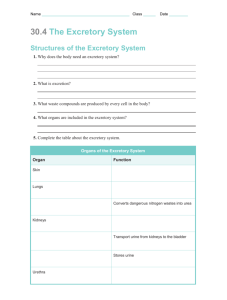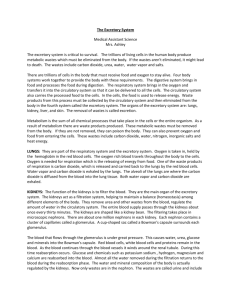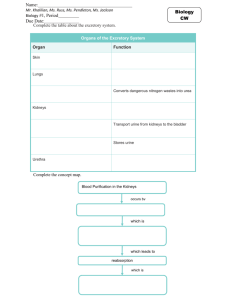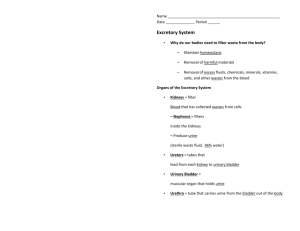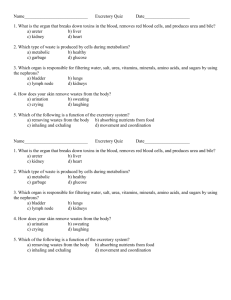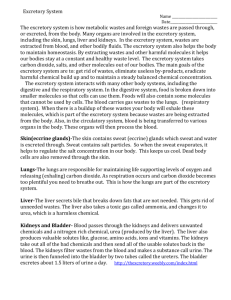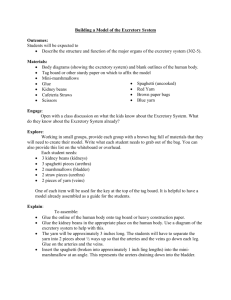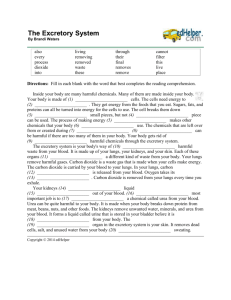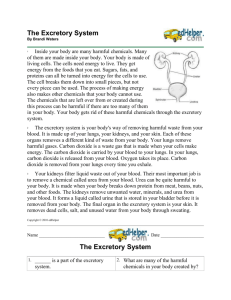The Excretory System - Discovery Education
advertisement
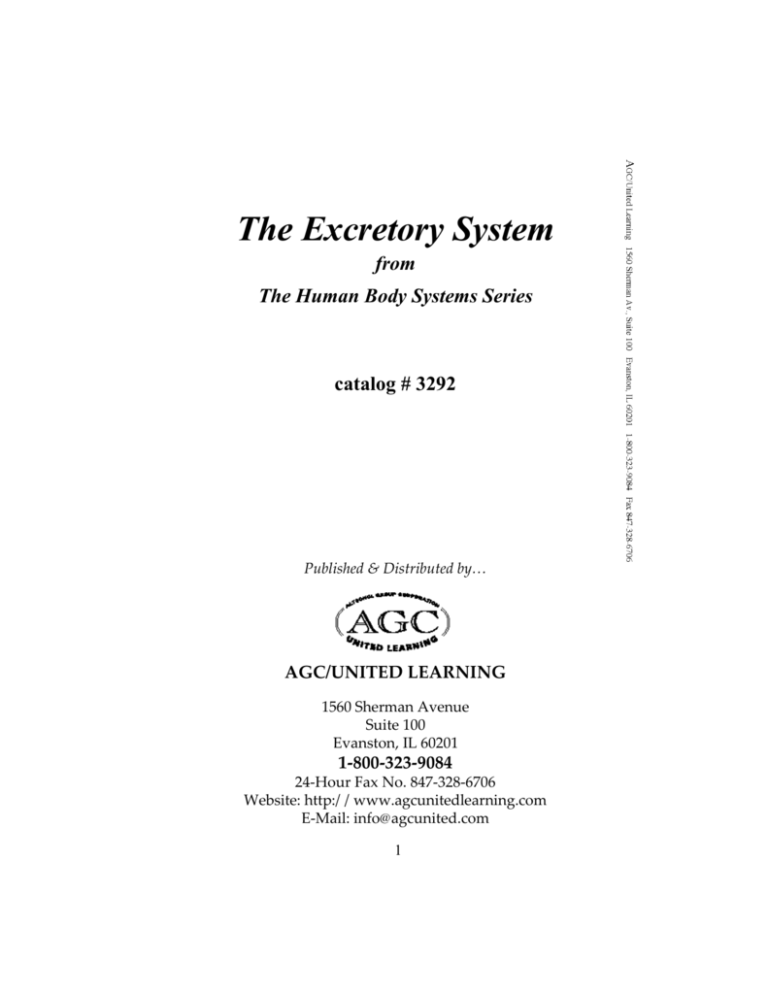
The Excretory System from The Human Body Systems Series catalog # 3292 Published & Distributed by… AGC/UNITED LEARNING 1560 Sherman Avenue Suite 100 Evanston, IL 60201 1-800-323-9084 24-Hour Fax No. 847-328-6706 Website: http://www.agcunitedlearning.com E-Mail: info@agcunited.com 1 THE EXCRETORY SYSTEM Grade Levels: 6-9 (Review for Grades 10-12) Viewing Time: 17 minutes with video quiz INTRODUCTION This video is designed for use in grades 6 - 9 as an introduction to the major ideas and concepts associated with the human excretory system, and for use in grades 10 - 12 as review. PROGRAM OBJECTIVES After viewing the video and participating in the accompanying activities, the students will be able to achieve the following objectives: • Describe the function and workings of the excretory system. • Identify the main parts of the excretory system. • Identify the way the kidneys filter the blood. • Define key vocabulary terms associated with the excretory system. SUMMARY OF THE VIDEO This video describes the functions of the excretory system. The excretory system is critical to survival. The trillions of living cells in the human body produce metabolic wastes which must be eliminated from the body. If the wastes aren’t eliminated, it might lead to death. These wastes include carbon dioxide, urea, water, water vapor, and salts. There are four organs that make up the excretory system: the lungs, kidneys, liver, and skin. 2 INSTRUCTIONAL NOTES Before presenting this lesson to your students, we suggest that you preview the video and review this guide and the accompanying blackline master activities in order to familiarize yourself with their content. Duplicate any blackline masters you wish to distribute. If you choose to use the Video Quiz, which immediately follows the video presentation, you may wish to distribute Blackline Master 1, Video Quiz, before showing the video. Also, plan to pause the tape between questions if students require more time. As you review the materials presented in this guide, you may find it necessary to make some changes, additions, or deletions to meet the specific needs of your class. We encourage you to do so, for only by tailoring this program to your class will they obtain the maximum instructional benefits afforded by the materials. It is also suggested that the video presentation take place before the entire group under your supervision. The lesson activities grow out of the context of the video; therefore, the presentation should be a common experience for all students. INTRODUCING THE VIDEO Remind the class that there are different systems of the body that work together to keep the body functioning properly. One of the most important systems is the excretory system which eliminates wastes from the body. Present the video. The viewing time is 12 minutes for the program and about 5 minutes for the Video Quiz. 3 BLACKLINE MASTER DESCRIPTIONS Most of the follow-up activities for this program are designed for middle school grades. If you use this program with an older audience, you will need to adapt the materials appropriately. Blackline Master 1, Video Quiz, is to be used at the end of the video program. At the completion of the video, there is a short quiz. The narrator will read the questions which are displayed on the screen. Students can use this sheet to record their answers. Answers to the questions are provided in the Answer Key on page 4 . Blackline Master 2, Vocabulary, is a collection of important vocabulary words from the video. You may want to distribute this sheet before viewing the video so students can listen for definitions. Blackline Master 3, The Kidneys, contains a diagram of the urinary system. At the bottom of the page, there is a box containing the names of the key components of the kidneys and urinary system. Students are to place the names next to the appropriate lines on the diagram. Blackline Master 4, Nephrons, asks students to fill in the blanks with terms from the box at the bottom of the page. Some words will be used more than once and some won’t be used at all. Blackline Master 5, Quiz, is the formal test for this unit of study. INTERNET ACTIVITIES 1. Visit the American Kidney Fund homepage at http://www.arbon.com/kidney This site includes information on public and patient education, research and rehabilitation, and donation information. 4 2. The American Liver Foundation website at http://gi.ucsf.edu/alf.html contains information on liver health and disease, new technology, and testimonials from liver disease patients and their families. DISCUSSION QUESTIONS 1. Discuss the relationship between the digestive, respiratory, circulatory, and excretory systems. 2. Discuss how the kidneys filter the blood. 3. Discuss the important roles perspiration plays in excretion and body temperature. ANSWER KEY Blackline Master 1, Video Quiz 1. lungs, kidneys, liver, and skin 2. The living cells of the body produce wastes during cell metabolism. If the wastes are not removed, they would build up in the cells, organs, and blood to such a degree that nutrients and oxygen wouldn’t be able to enter the cells to be used for energy. 3. Within each kidney are one million microscopic nephrons where filtering takes place. A cluster of capillaries called a glomerulus is surrounded by a cup-shaped sac called the Bowman’s capsule. Water, urea, glucose, and minerals in the blood move into the Bowman’s capsule. Reabsorption of some of this material and most of the water takes place while the blood continues to weave around the renal tubule. Wastes that are left after reabsorption collect as urine and are sent to the bladder. 4. As perspiration is released to the surface of the skin, it evaporates, or changes from a liquid into a gas. To make this change, heat from the body is used up, and as a result, 5 there is a loss of heat from the body, resulting in a cooling effect. 5. The top layer of the skin is called the epidermis. Below this layer is the dermis. 6. Urine is made up water, urea, and inorganic salts. 7. The bladder collects the urine before it is eliminated from the body through the urethra. 8. Homeostatsis is a term that refers to the balance of chemicals and elements within the body. 9. The lungs are a part of the respiratory and excretory systems. The lungs collect the metabolic waste carbon dioxide and eliminate it from the body. The circulatory system gathers the carbon dioxide from living body cells and returns it to the alveoli of the lungs. The carbon dioxide moves from the blood to the alveoli where it is then exhaled. Water vapor is also released during exhaling. 10. The kidneys are about the size of a large bar of soap and are shaped like kidney beans. They are located on either side of the spinal cord at about waist height. Blackline Master 2, Vocabulary 1. metabolism - all the chemical reactions that take place in an organism 2. excretory system - system which eliminates metabolic wastes from the body 3. alveoli - incredibly small sacs found inside the lungs where the exchange of gases takes place 4. capillaries - the tiniest blood vessels in the body 5. kidneys - two kidney-bean shaped organs responsible for filtering the blood 6. homeostasis - a state of balance between the elements of the body 7. nephron - location of true filtering of the blood; millions are found inside each kidney. 8. urine - waste product made of water, urea, and inorganic salts 6 9. ureter - tube leading from kidneys to the bladder 10. bladder - storage place for the waste products given off by the kidneys 11. urethra - tube leading from the bladder to outside the body 12. liver - organ which performs many roles; it stores some digested food, removes sugar from the blood and stores it as glycogen for future use; changes hemoglobin from dead red blood cells into bile; forms urea and sends it to the kidneys, removes various poisons, and removes bacteria from large intestine 13. epidermis - outermost layer of skin made of dead skin cells. 14. dermis - living layer of skin found below the epidermis Blackline Master 3, The Kidneys 7 Blackline Master 4, Nephrons Within each kidney are an estimated one million microscopic nephrons. Filtering of the blood takes place within these areas. Each nephron contains a cluster of capillaries called a glomerulus. A cup-shaped sac called a Bowman’s capsule surrounds each glomerulus. The blood that flows through the glomerulus is under great pressure. This causes water, urea, glucose, and minerals into the Bowman’s capsule. Red blood cells, white blood cells, and proteins remain in the blood. As the blood continues through the blood vessels, it winds around the renal tubula. During this time, reabsorption occurs. Glucose and chemicals, such as potassium, sodium, hydrogen, magnesium and calcium, are reabsorbed into the blood. Almost all the water removed during filtration returns to the blood during the reabsorption phase. The kidneys control the amount of liquid in our bodies. Now only wastes are left in the nephron. These wastes are called urine and include water, urea, and inorganic salts. The cleansed blood goes into veins that carry the blood from the kidneys and back to the heart. Blackline Master 5, Quiz 1. The excretory system is responsible for eliminating metabolic wastes from the body. 2. Lungs, kidneys, liver, and skin. 3. If the wastes aren’t eliminated, then there isn’t room for fresh food and oxygen in living cells. 4. The lungs exhale carbon dioxide from the body. 5. The kidneys filter blood through the use of millions of tiny nephrons which work at the capillary level. Water, urea, glucose, and minerals move into a hollow tube called the renal tubula. Capillaries wind around the renal tubula and reabsorb most of the water back into the circulatory system. The wastes removed become a fluid called urine and move into the bladder and then are released from the body through the urethra. 8 6. The liver removes poisonous substances from our bodies, such as mercury from fish, poisonous fumes from paint, and chemicals sprayed on food. 7. Perspiration is released out of the skin where it evaporates or changes from a liquid to a gas. The heat energy required to change from a liquid to a gas comes from the body. So the body loses heat and cools off. 8. Perspiration contains water, urea, and inorganic salts. 9. Urea is a nitrogen compound released when amino acids are changed into sugars, glycogen, or fats. The nitrogen is changed by the liver into urea which is then sent to the kidneys. 10. The bladder is the storage sac for urine before elimination from the body. SCRIPT OF VIDEO NARRATION THE EXCRETORY SYSTEM Can you imagine what it would be like if the garbage trucks stop running for awhile? It wouldn’t take long before there would be a serious problem. Garbage and trash would start piling up fast. It’s obvious that a method for removing wastes is an important part of every community. Well the same thing holds true for our bodies. There are wastes produced in our bodies that must be removed or else the body can suffer and even die. The removal of wastes from an organism is called excretion and is the topic of this video tape. There are trillions of living cells in the body which must receive food and oxygen to stay alive. Four body systems work together to gather these requirements. The digestive system brings in food and processes the food during digestion. The respiratory system brings in the oxygen and transfers it into the circulatory system so that it can be delivered to all the cells. The circulatory system also carries the processed food to the the cells. In the cells, the food is 9 used to release energy. Waste products from this process must be collected by the circulatory system and then eliminated from the body in the fourth system called the excretory system. Metabolism is the sum of all chemical processes that take place in the cells or entire organism. As a result of metabolism there are waste products produced. These wastes, which are called metabolic wastes, must be eliminated from the organism. If the wastes build up they can poison the body. They can also prevent oxygen and food from entering the cells. These wastes include carbon dioxide, water, nitrogen, inorganic salts, and heat. The organs of the excretory system are the lungs, the kidneys, the liver, and the skin. THE LUNGS The lungs are apart of the respiratory system and the excretory system. Air is breathed into the lungs and a gas exchange takes place inside the tiny air sacs of the lungs called alveoli. Oxygen from the air moves through the thin walls of the alveoli and through the walls of the capillaries or microscopic blood vessels that surround the alveoli. The oxygen is attracted to and held by the hemoglobin in the red blood cells. The oxygen rich blood will move back to the heart and receive a giant push to travel throughout the body. The oxygen will then be released to living cells. The cells need oxygen to carry on respiration, which is the releasing of energy from food and oxygen within the individual cells. The waste product carbon dioxide is produced during this process. It is released to the red blood cells and then carried back to the lungs for elimination from the body. The carbon dioxide travels from the red blood cells and moves into the alveoli. From there it is exhaled from the body when a person breathes out. Water vapor is also exhaled during this process. 10 THE KIDNEYS The kidneys are the main organs of the excretory system. They are a little larger than a bar of soap and are shaped like kidney beans. They are located just above the waist with one on each side of the spinal column. The two kidneys are protected by layers of fat and by the bottom ribs. They are behind the stomach. They are the body's filtration system. The kidneys help to maintain a balance among the elements inside the body. This balance is referred to as homeostasis. The kidneys perform the following important jobs. They remove urea and other wastes from the blood, regulate the amount of water in the circulatory system, and adjust the amounts of certain substances in the blood. The kidneys filter wastes and poisons from the blood at an incredible rate. They filter about one fourth of a liter of blood per minute as it is sent to them through arteries of the circulatory system. This means that the entire blood supply passes through the kidneys once every 30 minutes. Within each kidney are an estimated one million microscopic nephrons where the filtering actually takes place. This complex network of capillaries and nephron tubes is illustrated here. Each nephron contains a cluster of capillaries called a glomerulus (glah MEHR yoo luhs). A cup-shaped sac called a Bowman’s capsule surrounds each glomerulus. The blood that flows through the glomerulus is under great pressure. This causes water, urea, glucose, and minerals into the Bowman’s capsule. Red blood cells, white blood cells, and proteins remain in the blood. As the blood continues through the blood vessels it winds around the renal tubule. During this time reabsorption occurs. Glucose and chemicals such as potassium, sodium, hydrogen, magnesium and calcium are reabsorbed into the blood. Almost all the water removed during filtration returns to the blood during the reabsorption phase. The water and mineral composition of the body is actually regulated by the kidneys. The kidneys control the amount of liquid in our bodies. Now 11 only wastes are in the nephron. These wastes are called urine and include water, urea, and inorganic salts. There may also be some sugar and nutrients present if there is an excess of these substances in the blood. The cleansed blood goes into veins that carry the blood from the kidneys and into a major vein that carries the blood back to the heart. From the heart the cleansed blood will circulate throughout the body. THE BLADDER The urine travels from the nephrons into the center of the kidneys. A tube called the ureter (yoo-reet-er) will carry the urine, which is amber colored, as it travels into a muscular sac called the bladder. The bladder is capable of holding about 470 milliliters of urine. When the bladder is full a signal is sent to the brain and the fluid is released into the urethra (yoo-REE-thruh). This is a tube that leads outside of the body. The urine is released during a process called urination. THE LIVER The liver, which is located just to the right of the stomach, is another organ that plays a major role in excretion. Food that has been digested in the small intestine travels to the liver where some of it is stored and released back to the blood stream in a controlled fashion. Sugar in the blood is removed in the liver and stored as glycogen (glie-koh-jin). When the sugar level in the blood goes down, the liver breaks down the glycogen and releases sugar back into the blood. If there is no room in the liver to store glycogen, the liver changes the sugar to fat and stores it in other parts of the body. Blood sugar level is important because sugar is the energy provider for all the cells of the body. If the liver’s supply of glycogen runs out, it converts these fats to sugars. Amino acids release nitrogen when they are changed into sugars, glycogen, or fats. This nitrogen is changed by the 12 liver into urea which is carried to the kidneys by the blood stream. The urea will be eliminated from the body from the kidneys. The liver also removes from our bodies poisonous substances, such as mercury in fish, poisonous fumes from paint, and chemicals sprayed on food. The liver is our bodies main defense from poisons like those mentioned above. The liver also changes hemoglobin from dead red blood cells into bile, which is used in the small intestine to breakdown fats. Bacteria from the large intestine is removed from the blood by the liver. THE SKIN The last member of the excretory team is the skin. The skin is the largest organ of the body. It covers an area of 1.5 to 2 square meters in an average adult. That represents a space about the size of a small area rug. The thickness of the skin varies from a .5 millimeters on the eyelids to 6 millimeters on the soles of the feet. There are two general layers of the skin. The outer layer is called the epidermis and is made up of layers of flat cells. The surface cells of this layer are dead. They are constantly rubbing off and being replaced by cells below them. This outer layer of skin provides a waterproof shield against germs and bacteria. Under the epidermis is a layer called the dermis. The cells in this layer are all alive. This layer contains blood vessels, nerve endings, sweat and oil glands, hair follicles, and fat cells. The sweat glands have tubes that lead to the surface of the skin at points called sweat pores. Perspiration is released at these sweat pores. Water, urea, and inorganic salts are included in perspiration. Besides ridding the body of these wastes, perspiration also cools the body and helps maintain a proper body temperature. When you exercise, 13 work hard, or if the temperature of your surroundings is high you sweat or perspire. The sweat evaporates when it reaches the surface of the skin. During evaporation, heat is required to change the liquid to a gas. This heat comes from the body. Therefore, the body is cooled as the sweat evaporates. SUMMARY Today we have taken a close look at the excretory system of the human being. This system works with other systems to maintain a healthy body. The liver, kidneys, lungs, and skin are the organs of the excretory system. The lungs are responsible for releasing carbon dioxide and water vapor from the body. The liver and kidneys filter materials from the blood. The skin has sweat glands that release water, salts, and urea. Perspiration also cools the body and helps to keep a balanced body temperature. The excretory system is crucial to survival. If the system doesn’t perform properly the concequence can mean death. VIDEO QUIZ Students may write the answers to the following questions on a separate piece of paper or on the duplicating master titled Video Quiz (Blackline Master 1). 1. What are the four organs of the excretory system? 2. Why is the excretory system important to the human body? 3. How do kidneys clean the blood? 4. How is perspiration important to regulating body temperature? 5. What are the names of the two main layers of the skin? 6. What is urine? 7. What job does the bladder perform? 8. What does the term homeostasis mean? 9. What role do the lungs have in the excretory system? 10. How big are the kidneys and where are they located? 14 1 Name ________________ Date _________________ THE EXCRETORY SYSTEM Video Quiz Directions: At the end of the video production is a short quiz. You may write the answers to the quiz on this sheet. 1. What are the four organs of the excretory system? 2. Why is the excretory system important to the human body? 3. How do kidneys clean the blood? 4. How is perspiration important to regulating body temperature? 5. What are the names of the two main layers of the skin? 6. What is urine? 7. What job does the bladder perform? 8. What does the term homeostasis mean? 9. What role do the lungs have in the excretory system? 10. How big are the kidneys and where are they located? THE EXCRETORY SYSTEM from the Human Body Systems Series ©1998 AGC/United Learning 1560 Sherman Av., Suite 100 Evanston, IL 60201 1-800-323-9084 Fax 847-328-6706 www.agcunitedlearning.com e-mail: info@agcunited.com 2 Name ________________ Date _________________ THE EXCRETORY SYSTEM Vocabulary Directions: Write a definition for each of the terms listed below: 1. metabolism 2. excretory system 3. alveoli 4. capillaries 5. kidneys 6. homeostasis 7. nephron 8.urine 9. ureter 10. bladder 11. urethra 12. liver 13. epidermis 14. dermis THE EXCRETORY SYSTEM from the Human Body Systems Series ©1998 AGC/United Learning 1560 Sherman Av., Suite 100 Evanston, IL 60201 1-800-323-9084 Fax 847-328-6706 www.agcunitedlearning.com e-mail: info@agcunited.com 3 Name ________________ Date _________________ THE EXCRETORY SYSTEM The Kidneys Directions: Place the words from the box at the bottom of the page next to the appropriate lines on the diagram. Kidney Ureter Bladder Urethra Adrenal Glands THE EXCRETORY SYSTEM from the Human Body Systems Series ©1998 AGC/United Learning 1560 Sherman Av., Suite 100 Evanston, IL 60201 1-800-323-9084 Fax 847-328-6706 www.agcunitedlearning.com e-mail: info@agcunited.com 4 Name ________________ Date _________________ THE EXCRETORY SYSTEM Nephrons Directions: Use the words from the bottom of the page to fill in the missing spaces of the following paragraphs. Some words will be used more than once. Some won't be used at all. Within each kidney are an estimated one million microscopic nephrons. Filtering of the blood takes place within these areas. Each nephron contains a cluster of ___________ called a _______________. A cup-shaped sac called a ________________ capsule surrounds each _________________. The blood that flows through the ______________ is under great pressure. This causes ___________, _______, ________, and ______into the__________ capsule. __________________________, ______________, and __________ remain in the blood. As the blood continues through the blood vessels, it winds around the _____ _____. During this time, reabsorption occurs. Glucose and chemicals, such as potassium, sodium, hydrogen, magnesium and calcium, are reabsorbed into the blood. Almost all the ______ removed during filtration returns to the blood during the reabsorption phase. The kidneys control the amount of liquid in our bodies. Now only wastes are in the nephron. These wastes are called ________ and include ________, __________, and inorganic ______. The cleansed blood goes into _______ that carry the blood from the kidneys and back to the heart. veins water urea capillaries glucose minerals Bowman's glomerulus nephron red blood cells white blood cells proteins urine salts renal tubula THE EXCRETORY SYSTEM from the Human Body Systems Series ©1998 AGC/United Learning 1560 Sherman Av., Suite 100 Evanston, IL 60201 1-800-323-9084 Fax 847-328-6706 www.agcunitedlearning.com e-mail: info@agcunited.com 5 Name ________________ Date _________________ THE EXCRETORY SYSTEM Quiz Directions: Use the space provided to answer the following questions. Use the back of this sheet if necessary. 1. What is the function of the excretory system? 2. Name the four organs of the excretory system. 3. Why must metabolic wastes be eliminated from the body? 4. What job do the lungs perform in eliminating wastes from the body? 5. How do the kidneys filter the blood? 6. What role does the liver play in defending our bodies from poisonous substances? 7. One thing that perspiration does is cool the body. How does it do that? 8. What does perspiration contain? 9. What is urea? 10. What role does the bladder have in the functioning of the excretory system? THE EXCRETORY SYSTEM from the Human Body Systems Series ©1998 AGC/United Learning 1560 Sherman Av., Suite 100 Evanston, IL 60201 1-800-323-9084 Fax 847-328-6706 www.agcunitedlearning.com e-mail: info@agcunited.com
